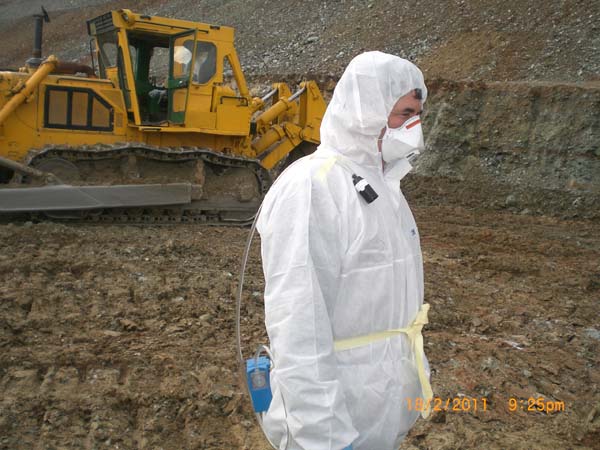Your Guide to Effective Asbestos Checking Procedures
Asbestos screening procedures are a vital component of ensuring the safety of interior environments, especially in older buildings where this unsafe product may be present. The prospective health and wellness risks related to asbestos exposure make it crucial to approach screening with accuracy and thoroughness. From understanding the homes of asbestos to successfully translating examination results, an extensive overview can gear up people with the expertise and tools required to browse this complicated process. Remain tuned to reveal the necessary steps and factors to consider that can aid you safeguard against the threats posed by asbestos.
Understanding Asbestos and Its Risks
Asbestos, a naturally occurring mineral known for its warm resistance and toughness, postures severe health and wellness dangers when its fibers are inhaled or consumed. asbestos inspection near me. Exposure to asbestos can lead to serious health and wellness conditions such as lung asbestosis, cancer, and mesothelioma. Regardless of its beneficial residential properties, asbestos has actually been extensively prohibited in numerous countries as a result of the tested web link between asbestos exposure and these serious illness
The risk lies in the tiny fibers that can quickly become air-borne when asbestos-containing materials are disrupted or harmed. Once breathed in, these fibers can become lodged in the lungs, triggering inflammation and scarring in time. The latency duration between exposure to asbestos and the growth of related illness can span several decades, making very early discovery and avoidance critical.
Asbestos was typically made use of in building products, insulation, and automobile components prior to its health and wellness threats were fully comprehended. Today, proper testing and removal of asbestos-containing materials are important to protect individuals from the risks associated with asbestos direct exposure.
Identifying Prospective Asbestos Materials
The recognition of potential asbestos products is an essential action in ensuring the safety and security of people subjected to hazardous compounds in different environments. Asbestos can be discovered in a variety of building products, including however not restricted to insulation, ceiling tiles, flooring tiles, cement sheets, and roof tiles - asbestos inspection near me. Determining these materials properly is essential to successfully handling the threats connected with asbestos exposure

In instances where visual inspection is undetermined, examples of thought products can be gathered and sent out to certified laboratories for screening. These research laboratories employ specialized techniques such as polarized light microscopy or transmission electron microscopy to properly determine the existence of asbestos straight from the source fibers in the examples. By following extensive recognition procedures, people can successfully minimize the threats connected with asbestos direct exposure.
Choosing the Right Screening Approach
Identification of prospective asbestos materials plays a vital role in establishing the suitable testing approach for accurate asbestos fiber discovery. There are two primary approaches for asbestos testing: polarized light microscopy (PLM) and transmission electron microscopy (TEM) It is crucial to consult with accredited asbestos screening experts to determine the most appropriate technique for your certain screening needs.
Performing Sample Collection Safely
When accumulating examples for asbestos screening, prioritizing security procedures is vital to minimize prospective direct exposure risks. Asbestos fibers are unsafe when disrupted, making it crucial to comply with correct safety methods during example collection - asbestos air testing. Before starting the tasting process, make sure that you are equipped with personal safety tools (PPE) such as non reusable coveralls, gloves, masks, and goggles to stop breathing or call with asbestos fibers
It is vital to wet the sampling location utilizing a gentle mist of water to avoid the fibers from coming to be airborne throughout collection. When collecting samples and prevent aggressive scuffing or drilling that could release asbestos fibers into the air, Usage care. Rather, thoroughly cut a small item of the material utilizing proper tools and place it into a sealed container for analysis by a qualified lab.
Additionally, identifying each sample with detailed details pertaining to the tasting area, collection agency, and date's name is important for accurate record-keeping and evaluation. By complying anonymous with these safety standards, you can conduct sample collection for asbestos testing successfully while reducing the threat of direct exposure.
Analyzing Test Outcomes and Next Steps

Conclusion
In verdict, efficient asbestos screening treatments are crucial in determining and managing prospective wellness threats connected with asbestos direct exposure. By comprehending the dangers of asbestos, determining possible materials, picking the ideal testing approach, conducting example collection securely, and translating examination results accurately, organizations and people can take the essential steps to secure themselves and others from the damaging results of asbestos. It is important to focus on security and appropriate screening protocols to guarantee a healthy atmosphere for all.

Recognition of prospective asbestos materials plays a critical function in determining the proper testing method for exact asbestos fiber detection. The examination results will indicate the existence or lack of asbestos, the type of asbestos fibers present, and the focus levels.In final thought, reliable asbestos testing treatments are necessary in identifying and handling possible health and wellness risks linked with asbestos exposure. By recognizing the dangers of asbestos, identifying possible products, choosing the ideal screening method, carrying out example collection securely, and interpreting test results properly, people and organizations can take the required actions to shield themselves and others from the damaging impacts of asbestos.